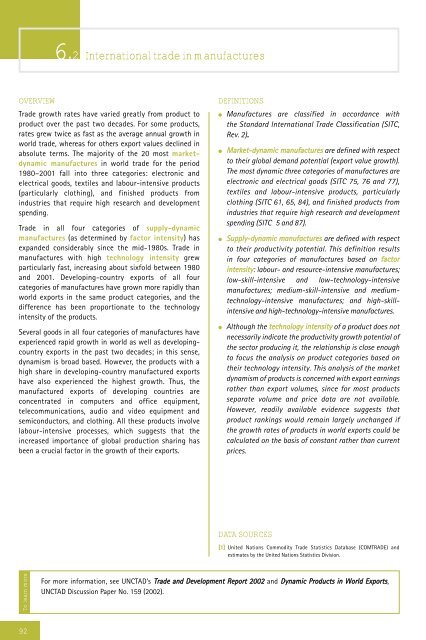Development and Globalization: - Unctad
Development and Globalization: - Unctad
Development and Globalization: - Unctad
You also want an ePaper? Increase the reach of your titles
YUMPU automatically turns print PDFs into web optimized ePapers that Google loves.
92<br />
6.2 International trade in manufactures<br />
OVERVIEW DEFINITIONS<br />
Trade growth rates have varied greatly from product to<br />
product over the past two decades. For some products,<br />
rates grew twice as fast as the average annual growth in<br />
world trade, whereas for others export values declined in<br />
absolute terms. The majority of the 20 most marketdynamic<br />
manufactures in world trade for the period<br />
1980–2001 fall into three categories: electronic <strong>and</strong><br />
electrical goods, textiles <strong>and</strong> labour-intensive products<br />
(particularly clothing), <strong>and</strong> finished products from<br />
industries that require high research <strong>and</strong> development<br />
spending.<br />
Trade in all four categories of supply-dynamic<br />
manufactures (as determined by factor intensity) has<br />
exp<strong>and</strong>ed considerably since the mid-1980s. Trade in<br />
manufactures with high technology intensity grew<br />
particularly fast, increasing about sixfold between 1980<br />
<strong>and</strong> 2001. Developing-country exports of all four<br />
categories of manufactures have grown more rapidly than<br />
world exports in the same product categories, <strong>and</strong> the<br />
difference has been proportionate to the technology<br />
intensity of the products.<br />
Several goods in all four categories of manufactures have<br />
experienced rapid growth in world as well as developingcountry<br />
exports in the past two decades; in this sense,<br />
dynamism is broad based. However, the products with a<br />
high share in developing-country manufactured exports<br />
have also experienced the highest growth. Thus, the<br />
manufactured exports of developing countries are<br />
concentrated in computers <strong>and</strong> office equipment,<br />
telecommunications, audio <strong>and</strong> video equipment <strong>and</strong><br />
semiconductors, <strong>and</strong> clothing. All these products involve<br />
labour-intensive processes, which suggests that the<br />
increased importance of global production sharing has<br />
been a crucial factor in the growth of their exports.<br />
To learn more<br />
● Manufactures are classified in accordance with<br />
the St<strong>and</strong>ard International Trade Classification (SITC,<br />
Rev. 2)..<br />
● MMaarrkkeett--ddyynnaammiicc mmaannuuffaaccttuurreess are defined with respect<br />
to their global dem<strong>and</strong> potential (export value growth).<br />
The most dynamic three categories of manufactures are<br />
electronic <strong>and</strong> electrical goods (SITC 75, 76 <strong>and</strong> 77),<br />
textiles <strong>and</strong> labour-intensive products, particularly<br />
clothing (SITC 61, 65, 84), <strong>and</strong> finished products from<br />
industries that require high research <strong>and</strong> development<br />
spending (SITC 5 <strong>and</strong> 87).<br />
● Supply-dynamic manufactures are defined with respect<br />
to their productivity potential. This definition results<br />
in four categories of manufactures based on ffaaccttoorr<br />
iinntteennssiittyy: labour- <strong>and</strong> resource-intensive manufactures;<br />
low-skill-intensive <strong>and</strong> low-technology-intensive<br />
manufactures; medium-skill-intensive <strong>and</strong> mediumtechnology-intensive<br />
manufactures; <strong>and</strong> high-skillintensive<br />
<strong>and</strong> high-technology-intensive manufactures.<br />
● Although the tteecchhnnoollooggyy iinntteennssiittyy of a product does not<br />
necessarily indicate the productivity growth potential of<br />
the sector producing it, the relationship is close enough<br />
to focus the analysis on product categories based on<br />
their technology intensity. This analysis of the market<br />
dynamism of products is concerned with export earnings<br />
rather than export volumes, since for most products<br />
separate volume <strong>and</strong> price data are not available.<br />
However, readily available evidence suggests that<br />
product rankings would remain largely unchanged if<br />
the growth rates of products in world exports could be<br />
calculated on the basis of constant rather than current<br />
prices.<br />
DATA SOURCES<br />
[1] United Nations Commodity Trade Statistics Database (COMTRADE) <strong>and</strong><br />
estimates by the United Nations Statistics Division.59.<br />
For more information, see UNCTAD’s TTrraaddee aanndd DDeevveellooppmmeenntt RReeppoorrtt 22000022 <strong>and</strong> DDyynnaammiicc PPrroodduuccttss iinn WWoorrlldd EExxppoorrttss,<br />
UNCTAD Discussion Paper No. 159 (2002).

















